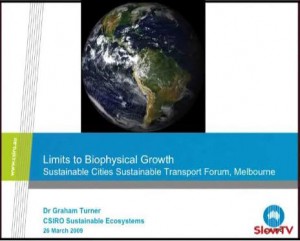How are the 1970s predictions of Limits to Growth made famous by “The Club of Rome” viewed today? (Click to see the video) published by The Monthly, displayed through SlowTV Dr Graham Turner is a senior research scientist at CSIRO Sustainable Ecosystems, Canberra ACT, Australia. “The Limits to Growth, published in 1972, was a landmark publication when released, one of the first studies to link the world economy with the state of the environment. At the Sustainable Cities, Sustainable Transport forum, Dr Graham Turner tracks how these scenarios have played out, relating to economic growth, trade, use of resources, population growth and environmental impacts. He then follows the projections into the near future. Dr Graham Turner is a senior research scientist at CSIRO Sustainable Ecosystems, Canberra ACT, Australia. His work involves whole-of-system analysis on the long-term physical sustainability of the environment and economy. With a background in applied physics, Turner develops and applies the Australian Stocks and Flows Framework to create ‘what if’ scenarios that quantify sustainability challenges and explore potential solutions. Melbourne, March 2009 Source: Roger Taylor, forum organiser and convenor Duration: 20m 44s A UN report argues that our present economic system is no longer viable.2012_Costanza_UN sustainable economy 2012 |
Crossroads for the Economy. from Herman E. Daly (“Father” of the concept of the Steady State Economy”), Economics in a Full World, “Scientific American”, Vol 293 #3, p.80 Growth is widely thought to be the panacea for all the major economic ills of the modern world. Poverty? Just grow the economy (that is, increase the production of goods and services and spur consumer spending) and watch wealth trickle down. Don’t try to redistribute wealth from rich to poor, because that slows growth. Unemployment? Increase demand for goods and services by lowering interest rates on loans and stimulating investment, which leads to more jobs as well as growth. Overpopulation? Just push economic growth and rely on the resulting demographic transition to reduce birth rates, as it did in the industrial nations during the 20th century. Environmental degradation? Trust in the environmental Kuznets curve, an empirical relation purporting to show that with ongoing growth in gross domestic product (GDP), pollution at first increases but then reaches a maximum and declines. Relying on growth in this way might be fine if the global economy existed in a void, but it does not. Rather the economy is a subsystem of the finite biosphere that supports it. Humankind must make the transition to a sustainable economy–one that takes heed of the inherent biophysical limits of the global ecosystem so that it can continue to operate long into the future. Overall, however, mainstream (also known as neoclassical) economists consider sustainability to be a fad and are overwhelmingly committed to growth. But the facts are plain and uncontestable: the biosphere is finite, nongrowing, closed (except for the constant input of solar energy), and constrained by the laws of thermodynamics. Any subsystem, such as the economy, must at some point cease growing and adapt itself to a dynamic equilibrium, something like a steady state. Birth rates must equal death rates, and production rates of commodities must equal depreciation rates. Because establishing and maintaining sustainable economy entails an enormous change of mind and heart by economists, politicians and voters, one night well be tempted to declare that such a project would be impossible. But the alternative to a sustainable economy, an ever growing economy, is biophysically impossible. In choosing between tackling a political impossibility and a biophysical impossibility, I would judge the latter to be the more impossible and take my chances with the former. The Plan The economy must be transformed so that is can be sustained over the long run. It must follow three precepts.
|
What We Can Do? Join the Centre For the Advancement of the Steady State Economy. Share the Ross Gittin’s video, “Is A Steady State Economy Feasible?” Arrange to see the video “Hooked on Growth” and share it with your friends. |
|